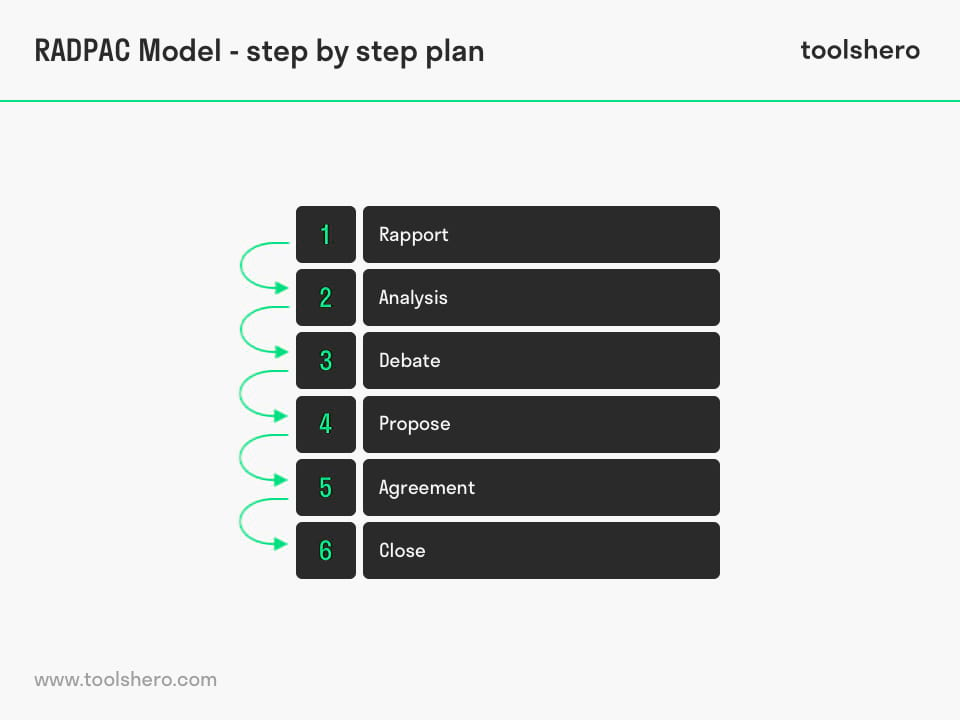RADPAC Model

RADPAC model: this article provides a practical explanation of the RADPAC model. After reading, you’ll have a basic understanding of this powerful management tool.
What is the RADPAC model of negotiation?
The RADPAC model is a negotiation model for organisations. Many different negotiation models have been published in the past, including the win-win model and win-lose model. The RADPAC model of negotiation describes negotiation as a process, in which each letter in the acronym represents a different part.
Negotiations often occur in the business world, but also beyond. A negotiation can be defined as a dialogue between two or more parties, with the aim of achieving a favourable outcome for a specific issue. This favourable outcome may be for one party, but also for both or all parties.
Negotiation is a process in which people resolve differences. In most cases, compromises are made. People often try to create a favourable outcome for themselves or their organisation. However, achieving a solution that benefits both parties, and in which their relationship doesn’t suffer, is the key to successful negotiation.
The RADPAC model of negotiation consists of the following elements. Together, they form the negotiation process: rapport, analysis, debate, propose, agreement, close. The model is often used in relatively formal negotiations, and is a standard part of many negotiation courses.
Negotiations Step-by-step Plan
The RADPAC model of negotiation consists of six different phases. Below is a short summary of each phase. Ensure that it is clear in advance what will be negotiated, and that the right people are in the right location at the right time. Ensure negotiations take place in a neutral location.
1. Rapport
At the start of negotiations, it is important that all parties have a good rapport with each other, and that they feel at ease. Use several minutes to get to know each other, to create positive impressions, to search for information and directions, and to seek understanding.
2. Analysis
In this development phase, all parties take the time to understand each other. Always emphasise the sharing of interests. This phase is about:
- Identifying needs and interests
- Building understanding
- Making and sharing assumptions
- Gathering facts
- Sharing opinions
- Expressing feelings
3. Debate
The third phase of the RADPAC model of negotiation covers the different interests and opinions that have been shared. Nothing will be achieved without discussion. This round includes openly discussing problems when it comes to conflicting interests.
A solution is sought, and the pros and cons of each proposed idea are evaluated. The goal of a debate is for each party to convince the other. When debating, it is important to remain patient and calm. Results of this phase include:
- Potential solutions
- Summary
- Clarification
4. Propose
In this fourth step of the negotiation process for organisations and individuals, everyone selects the best idea that was shared in the previous round.
Each person explains why a particular idea appeals to them, how it will resolve a conflict of interest, and how it can be implemented. Activities in this phase include:
- Proposing ideas
- Summarising
- Sharing and showing interest
5. Agreement
In this penultimate phase, consensus is reached by a vote. In this voting round, each participant votes for the best possible idea or alternative. The idea or solution with the most votes is then adopted.
6. Close
In the final phase of the RADPAC model of negotiation, the negotiation is complete and the participants return to their respective environments. Before they leave, the results are summarised and discussed, and future steps are planned.
How Can I Negotiate Effectively?
A negotiator is a person who participates in a negotiation and who tries to reach an agreement. Negotiations sometimes take a long time and can be complex.
Negotiation is a skill that must be trained in order to be carried out effectively and correctly, in combination with the various techniques that are used.
Characteristics of the Negotiator
Effective negotiators usually have a set of shared characteristics. Examples of good negotiation characteristics include:
- Always being well-prepared
- Having knowledge of the matter at hand
- Having the ability to think clearly under pressure and uncertainty
- Having excellent listening skills
- Being able to estimate situations well
- Being integer
- Being patient
- Being decisive
- Considering multiple options
- Being aware of the style of the other negotiator
- Being flexible
- Having excellent language proficiency
- Being good at body language
- Having strong emphatic skills
Negotiating Skills
The characteristics described above are the result of skills in key areas of negotiation. One shortcoming of the RADPAC model of negotiation is that it doesn’t take environmental factors into account.
However, the general quality of negotiation depends to a large extent on the negotiating skills of both parties. The following skills are important for negotiators:
- Empathy
- Listening skills
- Questioning skills
- A well-trained memory
- Focus
- Language
- Non-verbal skills
RADPAC model : Negotiations in Practice
There are different types of situations where negotiation is necessary, desirable, or routine. These situations vary from formal situations at work to informal situations at home and from structured meetings to unstructured problem-solving situations.
Formal Situations
- Progress interviews and discussions
- Assessment interviews
- Agenda meetings with employees or trade unions
- Budget meetings
- Problem situations
Informal situations
- One-on-one meetings
- Problem situations
- Routine meetings with employees
- Division of labour
RADPAC model examples
The RADPAC model of negotiation can be used in almost any negotiation situation. Trained negotiators have usually mastered methods and skills over time. Many organisations are interested in employing skilled negotiators.
Conflicts of interest are the order of the day in the business world. Discussions, negotiations, and ultimately even lawsuits are common in every industry. This particular example takes a look at Apple and Samsung. Both companies have been entangled in a legal conflict for many years now.
In 2011, Apple started a lawsuit against Samsung, in which it accused the Korean electronics giant of copying the look and feel of the iPhone.
In turn, Samsung accused Apple of having paid no royalties for using their technology. Although both parties expressed they would rather have avoided a legal battle, negotiations stalled in such a way that a judge had to be involved.
In major corporations with many interests, expensive technologies, and valuable intellectual property, this is more often the norm than for small organisations and informal situations.
The RADPAC model of negotiation can be best used in situations with relatively few stakeholders, and where the problems being discussed are concrete. Allegations of technological or design theft require extensive expertise and legal proceedings, and are therefore often handled through courts.
Now it’s your turn
What do you think? Are you familiar with the explanation about the RAPDAC model? What do you think are the pros and cons of this model? Have you ever been in a situation where you had to negotiate? Are you interested in sharing such a situation with us, or do you have any tips or additional comments?
Share your experience and knowledge in the comments box below.
More information
- Jevremovič, V. (2011). Negotiation models as tools for teaching Business English. Inter Alia, 2.
- Kremenyuk, V. A. (2002). International negotiation. Analysis, approaches, issues. Jossey-Bass.
- Ting-Toomey, S. (1988). A face negotiation theory. Theory and intercultural communication, 47-92.
- Young, H. P. (1991). Negotiation analysis. University of Michigan Press.
How to cite this article:
Janse, B. (2019). RADPAC Model. Retrieved [insert date] from Toolshero: https://www.toolshero.com/management/radpac-model/
Published on: 10/26/2019 | Last update: 05/20/2022
Add a link to this page on your website:
<a href=”https://www.toolshero.com/management/radpac-model/”>Toolshero: RADPAC Model</a>











